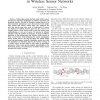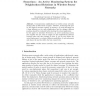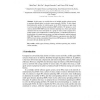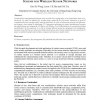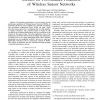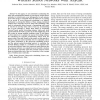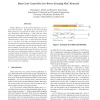GLOBECOM
2010
IEEE
13 years 9 months ago
2010
IEEE
Constructing sensing barriers using wireless sensor networks has important applications in military operations and homeland security. The goal of forming a sensing barrier is to de...
ADHOCNETS
2010
Springer
13 years 9 months ago
2010
Springer
Communication neighborhood in wireless sensor networks changes often as links break or appear. Therefore, monitoring link quality and (logical) network topology is necessary. As no...
ADHOCNETS
2010
Springer
13 years 9 months ago
2010
Springer
In this paper, we consider the use of multiple mobile software agents to perform different tasks in wireless sensor networks (WSNs). To this regard, determining the number of mobil...
CORR
2010
Springer
13 years 9 months ago
2010
Springer
Traditional key management techniques, such as public key cryptography or key distribution center (e.g., Kerberos), are often not effective for wireless sensor networks for the se...
WINET
2010
13 years 9 months ago
2010
Wireless sensor networks comprise typically dense deployments of large networks of small wireless capable sensor devices. In such networks, multicast is a fundamental routing servi...
VTC
2010
IEEE
13 years 9 months ago
2010
IEEE
—We present the derivation of a novel metric for the performance prediction of Wireless Sensor Networks (WSNs). In particular, the metric can be applied in, for example, monitori...
TPDS
2010
13 years 9 months ago
2010
—Geographic routing is an attractive localized routing scheme for wireless sensor networks (WSNs) due to its desirable scalability and efficiency. Maintaining neighborhood inform...
TON
2010
13 years 9 months ago
2010
—In this paper, we are interested in minimizing the delay and maximizing the lifetime of event-driven wireless sensor networks, for which events occur infrequently. In such syste...
TMC
2010
13 years 9 months ago
2010
Energy efficiency is of the utmost importance in wireless sensor networks. The family of low-power-listening MAC protocols was proposed to reduce one form of energy dissipation�...
TMC
2010
13 years 9 months ago
2010
—This paper presents SYNAPSE++, a system for over the air reprogramming of wireless sensor networks (WSNs). In contrast to previous solutions, which implement plain negative ackn...
